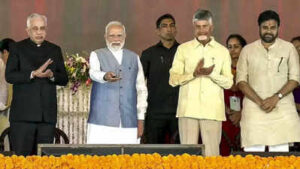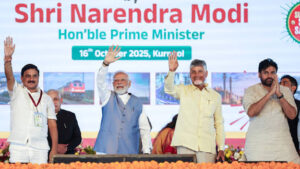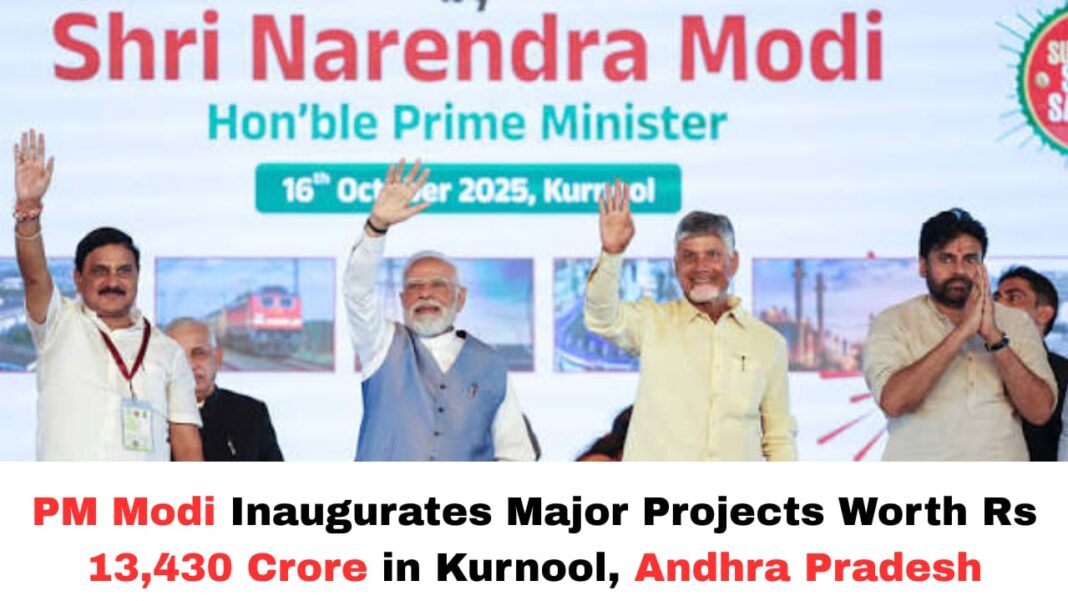Digital News Guru Andhra Pradesh Desk:
PM Modi Unveils Rs 13,430 Crore Development Push in Andhra Pradesh
In a major development push, PM Narendra Modi on October 16, 2025, inaugurated and laid the foundation stones for a suite of development and infrastructure projects totaling Rs 13,430 crore in Kurnool, Andhra Pradesh. The ambitious announcement reflects the Union Government’s focus on boosting industrial growth, improving connectivity, and expanding energy infrastructure in the state.
Key Project Highlights & Sectors
The projects span multiple critical sectors: industry, roads, railways, power transmission, energy, defence manufacturing, and natural gas and LPG supply. Major components include:

- Transmission & Renewable Energy Infrastructure
Modi laid the foundation stone for the Transmission System Strengthening project at the Kurnool-III Pooling Station, with a cost exceeding Rs 2,880 crore. The plan includes construction of a 765 kV double-circuit transmission line to Chilakaluripeta, boosting capacity by around 6,000 MVA, which will help integrate renewable energy more effectively into the grid. - Industrial Hubs in Rayalaseema
Two new industrial areas were announced: Orvakal (in Kurnool) and Kopparthy (in Kadapa). These hubs, jointly developed by NICDIT (National Industrial Corridor Development & Implementation Trust) and APIIC (Andhra Pradesh Industrial Infrastructure Corporation), account for Rs 4,920 crore of investment. Designed as “plug-and-play” multi-sectoral hubs with a walk-to-work concept, they are expected to attract further investments (estimated at ~Rs 21,000 crore) and generate roughly one lakh jobs. - Road and Highway Projects
Connectivity improvements are a major plank of the announcement. Modi unveiled a Greenfield six-lane highway between Sabbavaram and Sheelanagar (cost ~Rs 960 crore), aimed at decongesting traffic and boosting trade around Visakhapatnam. Several other road projects, totaling about Rs 1,140-2,100 crore, were also inaugurated or laid down. These include four-laning of Pileru-Kalur section, widening from Kadapa-Nellore border to CS Puram, a Rail Over Bridge (ROB) on NH-165 between Gudivada and Nujella Stations, Kanigiri Bypass on NH-565, and improvements in towns like N. Gundlapalli. - Railways
Over Rs 1,200 crore worth of railway projects were dedicated or foundations laid. Major among these are the Kothavalasa-Vizianagaram Fourth Railway Line, the rail flyover between Pendurthi and Simhachalam North, and the doubling of sections such as Kottavalasa-Boddavara and Shimiliguda-Gorapur. These projects are expected to ease passenger and freight movement, reducing travel time and improving capacity. - Energy & Natural Gas
The Srikakulam–Angul Natural Gas Pipeline of GAIL India was inaugurated; it spans ~124 km in Andhra Pradesh and about 298 km in Odisha, costing around Rs 1,730 crore. An LPG bottling plant in Chittoor (capacity ~60,000 Metric Tonnes per Annum) was also inaugurated (approx Rs 200 crore), serving several districts across Andhra Pradesh, Tamil Nadu, and Karnataka. - Defence Manufacturing & Technology
A Rs 360 crore Advanced Night Vision Products Factory was inaugurated in Nimmaluru, Krishna district (by Bharat Electronics Limited), focusing on electro‐optical systems. This reflects the government’s push toward self-reliance in defence technology.
Political, Symbolic & Regional Context
The announcement in Kurnool was part of a larger public rally, during which PM Modi highlighted the success of “Operation Sindoor”, a campaign emphasizing the strength of Indian-manufactured goods. He also praised the leadership of Chief Minister N. Chandrababu Naidu and Deputy CM Pawan Kalyan, saying Andhra Pradesh is entering a phase of accelerated development.

The Prime Minister made religious and cultural observances as part of the itinerary: a visit to Sri Bhramaramba Mallikarjuna Swamy Varla Devasthanam (Srisailam temple) in Nandyal district, performing darshan, and paying homage at Shivalinga shrines and other spiritual sites. These acts underscored the blending of cultural symbolism with the political narrative of development.
Expected Impact & Challenges
If fully realised, these projects are likely to have a considerable impact on Andhra Pradesh’s socio-economic landscape:
- Employment: The industrial hubs alone are projected to generate about 100,000 jobs, potentially transforming the Rayalaseema region by attracting new manufacturing units and ancillary industries.
- Connectivity & Trade: Upgraded roads, highway expansion, railway line enhancements, and pipeline infrastructure will reduce bottlenecks, shorten travel times, and potentially make trade and logistics more efficient. This may also help in linking remote areas to major economic centres.
- Energy & Sustainability: Strengthening transmission capacity and expanding natural gas pipeline networks will support renewable energy integration, improve energy security, and provide cleaner fuel options for households and industry.
But several challenges loom:
- Execution timelines: Projects of such scale require prompt land acquisition, clearances, contractor coordination, and adherence to timelines. Delays in any of these can stall benefits.
- Funding & Monitoring: While funds may be announced, spending flow, corruption risks, cost overruns, and proper monitoring will determine real outcomes. Oversight will be key.
- Inclusivity: Translating macro-infrastructure into improved quality of life for citizens—especially in rural or less developed parts—needs careful attention: access to services, local employment, social impact, etc.

Conclusion
The Rs 13,430 crore package represents a significant infusion of infrastructure and industrial development momentum in Andhra Pradesh. By investing across sectors—roads, rail, industry, power, and energy—the government is seeking to build capacity, improve connectivity, and generate employment. The projects align with broader goals of Atmanirbhar Bharat (Self-Reliant India), regional development of Rayalaseema, and leveraging India’s capabilities in manufacturing and technology.
However, as always, much will depend on how these projects are implemented—whether benefits reach the grassroots, whether timelines are met, and whether projections for investment and job creation are realised. For the people of Andhra Pradesh, especially in Kurnool, Kadapa, and beyond, the promise is large. The proof, as they say, will be in the delivery.
You May Also Read: ED Raids in West Bengal: Crackdown on Sand Smuggling Network








